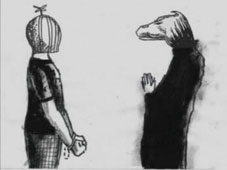Bettina NÜrnberg, Dirk Peuker
Franzosensand
Documentary | hdv | color | 8:30 | Austria, Germany | 2016
The film “Franzosensand” centers on agricultural settlements founded by theGerman National Socialitst on newly built dikes on the mudflat of the Wadden Sea (North Sea).
Of the settlements, the so-called “Adolf-Hitler-Koog”, was meant to be a prototype for a national socialist community.Today, the bleak and tidy landscape does not offer much testimony to its history. Excerpts of archived materials that are interwoven with present-day images make the present appear as a surface built on complex, deeper layers of the past.
Bettina NUERNBERG (1976, Germany) was educated in art and film in Hamburg, Berlin and Toulouse. The work of the Berlin-based artist has been screened and exhibited worldwide. She founded the internet platform vestibuel-film.
Dirk PEUKER (1970, Germany) studied film and art in Berlin and Vienna. The work of the experimental filmmaker and artist has been screened and exhibited worldwide.

